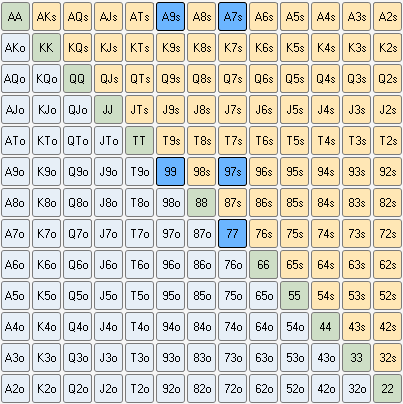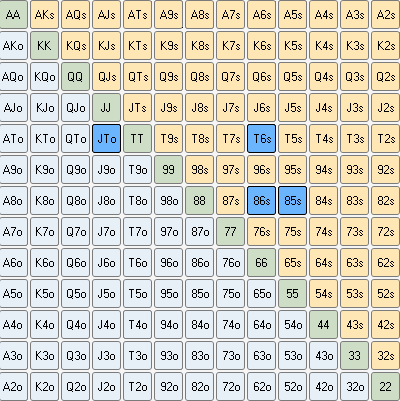Chapter 7: Check-raising
What is check-raising?
Check-raising is when a player checks the flop, turn, or river with one or more opponents acting afterward, and then raises if an opponent bets.
Constructing a check-raising range
You want to have a balanced strategy in which you check-raise some hands for value and some hands as semi-bluffs. This article is designed for the most common check-raising situation: when defending the small or big blind against a single preflop raiser. Nevertheless, the concepts discussed below are fundamental for check-raising in other situations, too.
A good beginner strategy is to check-raise with your hands of two pair plus and with your medium-strength draws some of the time.
Here is an example. UTG opens and you defend the big blind on a board of 9♣7♣A♦. Below is your range for check-raising for value.

You will notice that you are raising your two-pair hands, which are your A9s and A7s combos, as well as 97s. You will not have A9o and A7o, as these hands are better as a fold against the UTG range preflop.
Additionally, you can check-raise your sets for value. These are 99 and 77. You will not have top set (AA), as this would be a 3-bet preflop.
Now, you need to balance out this range with some bluffs. If you only check-raise for value, then your opponents can easily fold against you unless they have the very top of their range.
Your bluffing range could look like this.

In this situation, your flush draws are generally strong enough to simply flat call. You can check-raise your non-flush-draw gutshots, such as 86, 85, and T6 of spades, diamonds, and hearts. If your opponent re-raises, you can easily fold these weak hands. If your opponent calls, you can continue bluffing or you can hit a straight. 87 suited is also included, as it is an open-ended straight draw, which gives you better equity against your opponent.
How often should you be check-raising for value?
This depends on whether or not your opponent is likely to call your check-raise.
You need to look at your opponent’s fold to check-raise statistic. Bear in mind that it takes longer to develop a reasonable sample size for this statistic because of the rarity of check-raising.
- If your opponent has a low fold to check-raise statistic, you should be betting a depolarized check-raising range (depolarized means betting a top percentage of your hands). In the above images, you would only be using the first value range.
- If your opponent has a high fold to check-raise statistic, you should have a polarized check-raising range (polarized means that in addition to check-raising strong hands, you also check-raise some hands that are not quite strong enough to call). The more fold equity you have, the more semi-bluffs you can add to your check-raising range. A good beginner strategy for a balanced check-raise is to occasionally check-raise some medium-strength draws that can continue putting aggression on future streets depending on the turn and river cards.
Determining whether your hand is strong enough to check-raise for value
You need to assess your hand against the range of hands your opponent is likely to have. Hands like two pair plus are almost always strong enough to check-raise for value. Let’s look at the factors that determine whether your hand is good enough to check-raise for value.
- Your opponent’s UOPFR from the position they are currently raising from. The tighter the range, the stronger their hands. Your hand needs to be stronger to check-raise for value. You have less fold equity against a strong range.
- Your opponent’s in-position flop continuation-betting statistic. The lower this is, the stronger the hands that your opponent is deciding to continuation bet on the flop. This statistic needs to be understood in relation to the UOPFR of your opponent. For example, 50% of a UTG hand range will be much different from 50% of a BTN hand range. The advantage of raising almost entirely for value against this range is that, because your opponent is only continuation betting strong hands, this player is unlikely to fold against your check-raise. To learn more about UOPFR, read our unopened pre-flop raising guide.
Determining whether your hand is at risk
The more at risk your hand is, the more you want to check-raise for value.
- If there are draws on a board, such as straight draws or flush draws, even your strongest hands, like sets, two-pairs and overpairs, are at risk.
- If the draw completes on the turn or river, even if you are still ahead of your opponent you can lose action as your opponent’s relative hand strength will decrease.
- You opponent is more likely to put you on a bluff on a draw-heavy board than one with no draws.
If bluffing, is your opponent likely to continue to do so on the turn and river?
You should check-raise at a lower frequency on boards where your opponent is more likely to be bluffing and is likely to continue bluffing turns and rivers.
- Players generally bluff more on ace-high and king-high boards, and more often continue their aggression on the turn and river.
- You need to look at your opponent’s cbet turn and river percentages. The higher they are, the more likely that your opponent is going to continue bluffing. You must understand your opponent’s statistics on the flop and how they affect the turn and river ranges. For example, a player who is continuation betting only 30% on the flop and 60% on the turn will have a much stronger range of hands than someone betting 65% on the flop and 55% on the turn.
How do you decide whether you should check-raise as a semi-bluff?
If your opponent is folding to check-raises at a reasonable or high percentage, then you can use a polarized strategy of check-raising both for value and as a semi-bluff.
Understanding your fold equity
Your fold equity determines both the range and frequency with which you can check-raise against your opponent.
- The higher your opponent’s fold to check-raise percentage, the more fold equity you have.
- The wider your opponent’s preflop range, the more fold equity you have.
- The higher your opponent’s continuation betting percentage, the more fold equity you have.
- The tighter your image at the table, the more fold equity you will have.
Making sure your hand is not good enough to call
If your hand is good enough to call a bet with, you do not want to turn it into a semi-bluff.
- The higher your showdown value, the less often you should check-raise as a bluff.
- If your opponent’s range of hands includes many bluffs, medium-strength hands are better used to call than raise.
Choosing a range with equity to improve on turns and rivers
Your hand’s equity is very important to check-raising as a semi-bluff. You want to choose hands that can improve on the turn, allowing you to continue bluffing. This is done for two reasons.
- A hand with a backdoor flush draw and a gutshot has clear turn barreling options. (Barreling means to continue betting, in this case as a bluff. A “triple-barrel” bluff, for example, is when you bluff the flop, turn, and river.)
- You can improve to the best hand and win a big pot.
How to respond to a check-raise
Understanding how to respond to a check-raise will depend almost entirely on your opponent’s check-raised (CR) statistic in Poker Copilot.
Facing a value check-raise
If a player is check-raising 5% or less, it is extremely value-oriented. Your opponent is probably only check-raising sets, straights, and other very powerful hands.
Against this player, you should be inclined to fold all but your strongest hands. Even a hand like TPTK (top pair, top kicker; such as AQ on a board of Q78) is usually too weak to continue with. Think about the board and the range of hands your opponent is raising with. If someone is only raising 5%, then on the board of Q78 that player is usually check-raising with hands like 77, 88, 87, Q7, or Q8. Remember the images of a value range and bluffing range at the start of this article? Players with low check-raising percentages generally only have the value range.
Facing a bluff-heavy check-raising range
If someone is check-raising 10% or higher, this player is starting to become unbalanced in terms of bluffs.
Against these players, you can re-raise and get it in with your strongest draws and hands with top pair, good kicker or better; you can flat call your medium-strength hands; and you can fold the rest of your range.